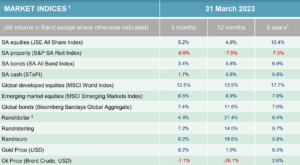March 2023 In Review
-
The Monetary Policy Committee (MPC) of the South African Reserve Bank surprised market participants with a 0.5% increase in the official lending rate. This was 0.25% higher than expected as the bank cited concerns about the persistence of inflation well above their 4.5% target. Governor Lesetja Kganyago said that guiding inflation back towards the mid-point of the target band would reduce the economic costs of high inflation and enable lower interest rates in the future. Achieving a prudent public debt level, increasing the supply of energy, moderating administered price inflation, and keeping wage growth in line with productivity gains would enhance the effectiveness of monetary policy and its transmission to the broader economy.
-
The South African Reserve Bank was not alone in raising interest rates in March. The US Federal Reserve (0.25%) and the European Central Bank (0.50%) also decided that the back of rising inflation has not been broken yet. The US Federal Reserve’s rate decision was the seventh consecutive hike. Chairman Powell’s testimony to Congress suggested there is likely to be further 0.25% hikes not just at the May meeting but also possibly in June. The timing of an inevitable Fed ‘pivot’ remains elusive since the hiking cycle is yet to end. But when it comes, cuts might be aggressive if disinflation is rapid, and recession is evident.
-
The collapse of Silicon Valley Bank and Signature Bank, and subsequent bail-out of Credit Suisse by their Swiss counterpart UBS, rocked markets mid-month. It seems as if the liquidity concerns that lead to this crisis are limited to banks with low-quality balance sheets. Against the backdrop of a cooling global economy, persistent high inflation, pressure on margins, and interest rates not pivoting yet, investors need to be prudent with their capital as the rising tide caused by decade-long low-interest rates has turned.
-
The Economic Freedom Fighters planned nationwide economic shutdown in South Africa on the 20th of March turned out to be no more than a storm in a teacup. Political economist, Dale McKinley, cited the proactivity of law enforcement as the reason for the muted impact. “The economic loss is not as great as what possibly was being projected precisely because the state responded proactively, saturated security-wise on many of the hotspots and even though some of the city centers and other places were very quiet, the economic losses beyond the closure of more medium and small-scale enterprises were not that great,” he said.
-
South Africa’s newly appointed electricity minister warned that record electricity outages could get even worse and said the state power utility’s performance targets need to be reviewed to determine whether they are appropriate. “All indications are that it is going to be difficult” as electricity demand increases going into winter and the dire energy situation could deteriorate further, Kgosientso Ramokgopa said in an interview with Bloomberg. “We need to set explicit targets” and those must be met to provide confidence to businesses, the markets, and households that the crisis is being addressed, he said. There still seems to be very little light at the end of the tunnel.
-
The South African government, through its Public Service Co-ordinating Bargaining Council, has sealed a 7.5% wage offer deal with the majority of public sector unions. This is far higher than National Treasury’s estimate when Finance Minister Enoch Godongwana delivered his budget speech in February and added nearly R38 billion to government expenses in 2023/2024.
Market Performance
Equity market returns in March were positive in the United States and Europe, with US volatility dropping at month end. In the US, the Fed’s continued tightening interest rate cycle is affecting growth, but the economy continues to be resilient. In Europe, equities continue to perform, while in China caution is offsetting the positive sentiment that followed the re-opening of the economy.
The Nasdaq 100 index was the outstanding performer as the technology-heavy indicator ended the month nearly 10% higher in US Dollar terms. The broader S&P 500 added 3.5% and the Euro Stoxx 50 ended the month 2% in the green (all in local currency terms).
Higher policy rates, weak domestic growth, and a softening global economy all weighed on the domestic equity market (up only 1.3%), as well as the property sector which had another poor month (-3.4%).
The Rand gained 3% against the US Dollar during March – much of it happening right at the end of the month as the Reserve Bank surprised markets with their higher-than-expected rate hike. Over the last twelve months, the greenback has still gained over 20% against our local currency.

- Source: Factset
- All performance numbers in excess of 12 months are annualised
- A negative number means fewer rands are being paid per US dollar, so it implies a strengthening of the rand.

